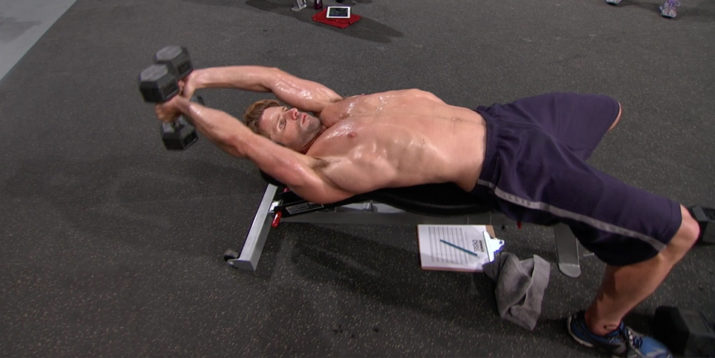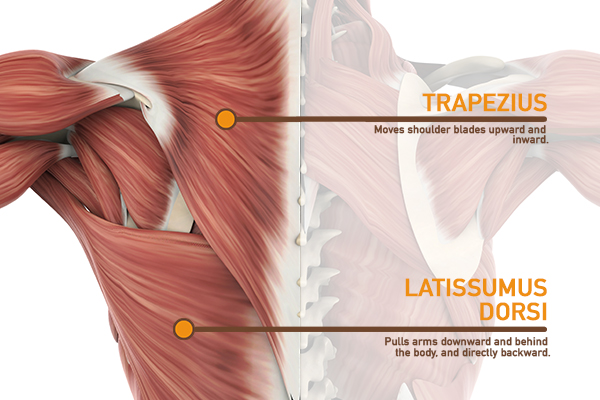How to Do a Dumbbell Pullover

The dumbbell pullover is a bit of a weight-room unicorn. Unlike nearly every other strength training exercise out there, it simultaneously works two opposing muscle groups at once—specifically, the pecs and lats.
So… do pullovers work your chest or back? The answer is both!
While the pectoralis major in the front of your chest controls pushing moments (think: push-ups and bench presses), the latissimus dorsi muscle, spanning both sides of the mid- to lower-back, powers pulling movements (think: rows and pull-ups).
It doesn’t get much more contradictory than that. However, by taking the shoulders through a huge range of motion, the dumbbell pullover exercise is able to tap both muscle groups. Here’s how to do it right.
Dumbbell Pullover: Step-by-Step Instructions
Appears in: The Master’s Hammer and Chisel – Total Body Chisel
- Holding a set of dumbbells, lay with your back flat on a bench or stability ball.
- With your feet planted on the ground and your core engaged, extend your arms to the sky, holding the dumbbells together above your chest.
- Keeping your low back pressed into the bench or stability ball, slowly lower your arms overhead until your biceps reach your ears.
- Slowly bring your arms back to above your chest and repeat.
How to Make the Dumbbell Pullover Easier
- Choose a lighter weight: Always select a weight that allows you to perform all reps with proper form.
- Do a bent arm dumbbell pullover: “You can regress the pullover by bending the elbows slightly,” says Sports Performance Coach Cody Braun. That will bring the weight slightly closer to your body to decrease the amount of stress placed on your core when the dumbbell is in its lowest position.
How to Make the Dumbbell Pullover Harder
- Choose a heavier weight: This is a simple way to increase the load on your pecs and lats.
- Hover your legs a few inches above the bench throughout the entire movement: Braun suggests this option that will be more challenging for your core than it will be for your pecs and lats. To maintain good form, though, you will likely need to use a lighter weight than you would otherwise, and it’s best to do this variation on the floor so you don’t have to worry about losing your balance laying on a bench.
Bonus Tips for Doing the Dumbbell Pullover

“The biggest key to executing the dumbbell pullover correctly is to keep your low back in contact with the bench throughout the whole exercise,” Braun says. Keeping the low back pressed into the bench requires high engagement of the core muscles, especially the deep-lying transverse abdominis.
On the flip side, if your low back arches up off of the bench during the dumbbell pullover, you’re likely not engaging the core as needed, or the weight might be too heavy for your core to stabilize it. You may even be “dumping” the weight into your low back, which can increase your risk of injury.
Dumbbell Pullover Benefits
This move works both the pecs and the lats, but it places special emphasis on strengthening the pecs.
If that isn’t enough, the dumbbell pullover exercise also increases core strength and stability, Braun says. “As the dumbbell gets farther away from your body, your core has to work harder to stabilize the spine.”
Dumbbell Pullover: Muscles Worked
The dumbbell pullover mainly hits your lats (latissimus dorsi) and your pecs (pectoralis major and pectoralis minor).
Lats

The lats are a part of your upper back. They’re a fan-shaped muscle originating at your mid and lower back and attaching to your upper arms.
In coordination with your trapezius and rhomboid muscles, your lats allow you to pull and row with ease.
Pecs

On the front side of your body, the pullover exercise works your pecs. You have one pectoralis major and pectoralis minor on each side of your body. Each pec major has two heads – one attaches to your collarbone, and the other attaches to your breastbone.
Both muscles fuse together to attach to your upper arm bone. The pec minor is situated just below, and it attaches to your upper ribs and the front side of your shoulder blades. Together, these muscles work to move your arm in multiple directions, helping you push, squeeze, carry, and more.
